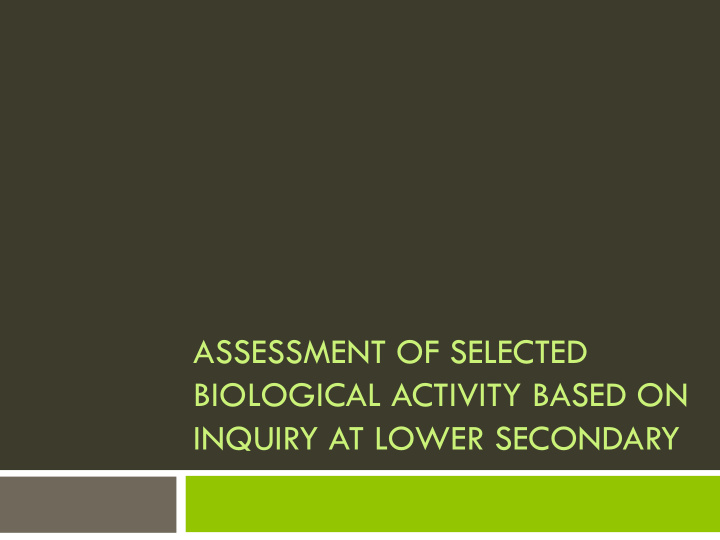



ASSESSMENT OF SELECTED BIOLOGICAL ACTIVITY BASED ON INQUIRY AT LOWER SECONDARY
Conditions Pupils aged 12-13 Two lower secondary schools Groups of three - four pupils Classroom, laboratory is not required
Our inquiry activity Plant nutrition, photosynthesis in algae modelling the effect of light intensity on photosynthesis in green algae immobilizing some algae, making jelly algal balls determining the rate of carbon dioxide absorption by using hydrogen carbonate indicator
Goals of activity Investigate how light intensity affects the rate of photosynthesis by using immobilised algae Assess the process of investigation
Traditional inquiry model related to our inquiry cycle I. interactive demonstration II. guided discovery with instructions III. controlled /guided/ inquiry IV. bounded inquiry V. open /free/ inquiry /K. Kimáková/
Assessment of IBSE activity Assessment of selected three key – moments of inquiry planning: 1. Distribution of algal balls 2. Layout of samples 3. Recording of constants and variables
1.Distibution of algal balls equally into three experimental containers a spoon a laboratory weighing scales - weighed three times the same weight volume using measuring cup
2. Setting up algal balls at different distances from the light Students chose appropriate locations alone after discussion.
3.Entry of constants and variables Groups discussed which data should be recorded The distance of sample from the lamp Volume of added indicator
How were the skills assessed? Providing feedback through discussion 1. Distribution of algal balls choice of method of distribution and justification 2. Location / layout/ of three samples relationship of distances from light and photosynthesis 3. Data presentation organize the data entry in table or graphs
Proposal of a draft graph
Proposal of a draft graph for younger children
Tasks in the worksheet: How does the colour of the indicator relate to the amount of carbon dioxide? In which of the samples was there the most intense photosynthesis?
Students ’ conclusions Students understand changes of indicator colour as a variable dependent on the distance of the sample from the light source. We missed: explanation of the relation of colour change to the change in CO 2 concentration accurate explanation of the relationship between the intensity of photosynthesis and the colour change of the indicator
Students' output Writer of the group -12 year old pupil - doesn't create a table for data display. A similar method of recording was also used by pupils from different groups in their presentation, which they created at home.
Students ’ output Students ’ graph
Conclusion of one of the groups We found that the further the glass was from the light the more the colour lightened. Students' formulation of the conclusion.
Criteria for judging assessment data skill Emerging Developing Consolidating Extending Planning an investigation 1. Distribution Indicates chosen Indicates Indicates chosen Indicates and method chosen method method and compares speed and of material and argues its argues its accuracy of chosen speed accuracy method 2. Layout of Procedure The layout is Able to reason the Able to reason the precise, but small less accurate, procedure in procedure, builds on samples distances time is practical terms the fundamental of between samples recorded photosynthesis (10cm) Data recorded Distinct process Distinct process Recording data about 3. Data entry into a continuous and results and results, colour of samples and text of process accurate data their distance from the entry light in pupil designed table
Conclusion controlled inquiry assessed pupil ’ s skills (participating in planning an experiment, activity during the course of the experiment) ability to collect data making solid conclusion
Our insights Double period of biology – long time of exposure to indicator Worksheet for students Draft graph
Students ’ experience
Thank you for your consideration
Recommend
More recommend